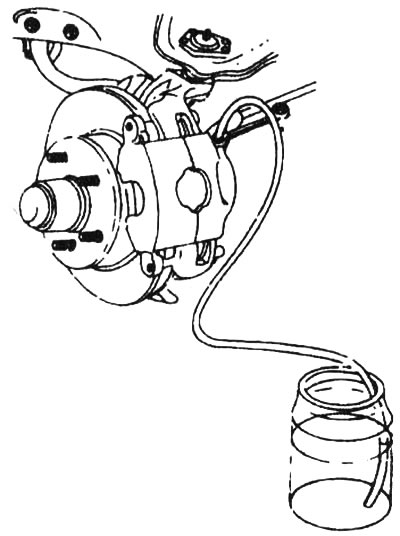Warning 1. On vehicles equipped with ABS, this procedure should not be performed because special tools are required to properly bleed the brakes. Take the car to a workshop where the appropriate tools are available.
Warning 2. When bleeding the brake system, always use eye protection. If liquid gets into your eyes, rinse immediately with plenty of water and seek medical attention.
Note. Bleeding the hydraulic system is necessary to remove the air that entered the system when it was opened when removing or installing hoses, lines, caliper or brake master cylinder.
1. If air has entered the system due to a low brake fluid level, or if the brake lines were disconnected at the master brake cylinder, you will need to bleed the system at all four brake assemblies.
2. If the brake line was disconnected at only one wheel, then it is necessary to bleed only that caliper or working brake cylinder to which it concerns.
3. If the brake line is disconnected at the fitting located between the main brake cylinder and any of the brake assemblies, it is necessary to bleed that part of the system that serves the disconnected line.
4. With the engine off, press the brake pedal several times to remove the residual vacuum in the brake booster.
5. Turn away a stopper of a tank of the main brake cylinder and fill a tank with a brake liquid. Reinstall the cap.
Note. When bleeding, check the fluid level frequently and top up if necessary, making sure the level does not drop enough to allow air bubbles to enter the brake master cylinder.
6. Have fresh brake fluid on hand. In addition, you will need an assistant, an empty, clean plastic container, a 3/16-inch piece of plastic, rubber, or vinyl tubing to fit over the bleed valve, and a key to open and close the valve.
7. Starting at the rear right wheel, loosen the bleed valve slightly, then tighten it to the point where it blocks the brake fluid path, tight enough, but so that it can be quickly and easily unscrewed.
8. Put the end of the tube on the bleed valve and dip the other end of the tube into the brake fluid in a container (see illustration).

9.8. When bleeding the brakes, the hose is connected to the bleeding valve at the caliper (or working brake cylinder), and then immersed in brake fluid. Air will be visible as bubbles in the vessel or tube. All air must be removed before moving on to the next wheel
9. Have a helper depress the brake pedal slowly a few times to pressurize the system, and then hold the pedal down while firmly depressing it.
10. While holding the pedal down, open the bleed valve just enough to allow fluid to flow through the valve. Watch for air bubbles that escape through the submerged end of the tube. When the fluid flow decreases after a couple of seconds, close the valve and have your assistant release the pedal.
11. Repeat steps 9 and 10 until no air comes out of the tube, then tighten the bleed valve and proceed to the left rear wheel, right front wheel, and then to the left front wheel (in that order) and follow the same procedure. Check the fluid level in the brake master cylinder reservoir.
12. Do not reuse old brake fluid. It contains water, which adversely affects the operation of the system.
13. Upon completion of the bleeding procedure, fill the master brake cylinder with brake fluid.
14. Check up action of brakes. You should feel the firmness of the pedal when pressed. Repeat the entire process if necessary.
Attention! Do not operate the vehicle if you are in doubt about the effectiveness of the braking system.
